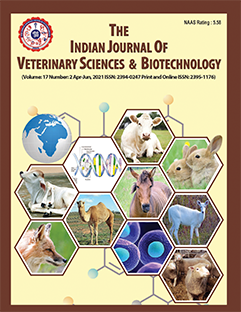Assessment of the Repellent Efficacy of Allomones against the Larval Stages of Brown Dog Tick
DOI:
https://doi.org/10.48165/ijvsbt.21.4.31Keywords:
Allomones, Brown dog tick, Repellent, Rhipicephalus sanguineus, SemiochemicalsAbstract
Ticks and tick-borne diseases are a major threat to livestock and companion animals. Hematophagous ticks transmit a variety of pathogens along with the direct effects such as tick worry and skin damages. Acaricides has been the mainstay in fighting off ticks until the emergence of resistance which forced researchers to look out for alternate tick control strategies. Allomones (non-host semiochemicals-NHC’s) are semiochemicals which benefit the host and deter the pests. The NHC’s in certain breeds of dogs have been elucidated and their function has been decoded. The current study was attempted in formulating a sustained release of these allomones using vapour patches and assessing their efficacy by in-vitro assay. It was found that allomones tested had a strong repellent effect on Rhipicephalus sanguineus comparable to that of the commercial repellent DEET.
Downloads
References
1. Bett, M.K., Saini, R.K., & Hassanali, A. (2015). Repellency of tsetse refractory waterbuck (Kobus defassa) body odor to Glossina pallidipes (Diptera: Glossinidae): Assessment of relative contribution of different classes and individual constituents. Acta Tropica, 146, 17–24.
2. Borges, L.M., Olveiria-Filho, J.G., Ferriera, L.L., Louly, C.C.B., Pickett, J.J., & Birkett, M.A. (2015). Identification of non-host semiochemicals for the brown dog tick, Rhipicephalus sanguineus sensu lato (Acari: Ixodidae) from tick-resistant beagles, Canis lupus familiaris. Ticks and Tick-Borne Diseases, 6, 676–682.
3. Ferreira, L.L., Sarria, A.L.F., de Oliveira Filho, J.G., de Silva, F.O., Powers, S.J., Caulfield, J.C., Pickett, J.A., Birkett, M.A., & Borges, L.M.F. (2019). Identification of a non-host semiochemical from tick-resistant donkeys (Equus asinus) against Amblyomma sculptum ticks. Ticks and Tick-Borne Diseases, 10(3), 621–627.
4. Gowrishankar, S., Latha, B.R., Sreekumar, C., & Leela, V. (2021). Lockdown effect of the brown dog tick within a bamboo sticky trap using sustained release pheromone beads in kennels. International Journal of Acarology, 47(2), 119–122.
5. Louly, C.C.B., Soares, S.F., Silveira, D.N., Neto, O.J., Silva, A.C., & Borges, L.M.F. (2009). Differences in the susceptibility of two breeds of dogs, English cocker spaniel and beagle to Rhipicephalus sanguineus (Acari: Ixodidae). International Journal of Acarology, 35, 25–32.
6. Louly, C.C.B., Soares, S.F., Silveira, D.N., Guimaraes, M.S., & Borges, L.M.F. (2010). Difference in the behaviour of Rhipicephalus sanguineus tested against resistant and susceptible dogs. Experimental and Applied Acarology, 51, 353–362.
7. Oliviera, F.J.G., Ferriera, L.L., Sarria, A.L.F., Pickett, J.A., Birkett, M.A., Mascarin, G.M., Leon, A.A.P., & Borges, L.M.F. (2017). Brown dog tick, Rhipicephalus sanguineus sensu lato, infestation of susceptible dog hosts is reduced by slow release semiochemicals from a less susceptible host. Ticks and Tick-Borne Diseases, 8, 139–145.
8. Reck, J., Souza, U., Souza, G., Kieling, E., DallAgnol, B., Webster, A., Michel, T., Doyle, R., Martins, T.F., Labruna, M.B., Marks, F., Ott, R., & Martins, J.R. (2018). Records of ticks on humans in Rio de Grande do Sul state, Brazil. Ticks and Tick-Borne Diseases, 9, 1296–1301.
9. Sonenshine, D.E. (1991). Biology of Ticks (Vol. 1). Oxford University Press, New York, USA.
10. Sonenshine, D.E. (2004). Pheromones and other semiochemicals of ticks and their use in tick control. Parasitology, 129, S405–S425.
11. Yoder, J.A., & Stevens, B.W. (2000). Attraction of immature stages of the American dog tick (Dermacentor variabilis) to 2,6-Dichlorophenol. Experimental and Applied Acarology, 24, 159–164.
Downloads
Published
Issue
Section
License
Copyright (c) 2025 Indian Journal of Veterinary Sciences and Biotechnology

This work is licensed under a Creative Commons Attribution-NonCommercial-NoDerivatives 4.0 International License.




